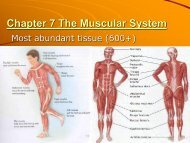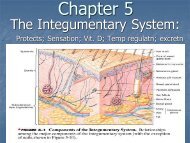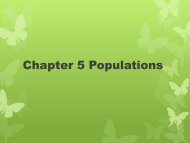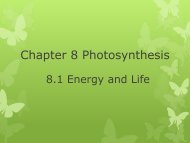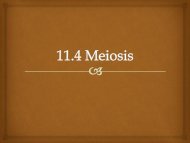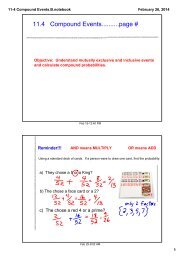Chapter 12 DNA.pdf
Chapter 12 DNA.pdf
Chapter 12 DNA.pdf
You also want an ePaper? Increase the reach of your titles
YUMPU automatically turns print PDFs into web optimized ePapers that Google loves.
<strong>Chapter</strong> <strong>12</strong> <strong>DNA</strong><br />
<strong>12</strong>.1 The Substance of Genes<br />
(p. 342-343)
A. Role of <strong>DNA</strong> (hereditary molecule)<br />
1. Storing Information<br />
‣ Genes written into <strong>DNA</strong> control development of each trait<br />
(ex: eye color gene)<br />
2. Copying Info<br />
‣ Every gene must be copied b4 division<br />
3. Transmitting Info<br />
‣ Genes made of <strong>DNA</strong> are sorted and passed on w/cell<br />
division/each generation
Section <strong>12</strong>.2<br />
A. Structure of <strong>DNA</strong><br />
1. Nucleic Acids (NA) and Nucleotides<br />
‣Acidic macromolecules<br />
‣Nucleotides are the building blocks (subunits) of <strong>DNA</strong><br />
•Deoxyribose (5C sugar)<br />
•Phosphate group<br />
•Nitrogenous base (molecule w/Nitrogen)
2. Nitrogenous Bases & Covalent Bonds<br />
‣ Contain nitrogen<br />
‣ 4 bases: Adenine/Guanine (2 rings) and<br />
Cytosine/Thymine (1 ring); A; G; C; T<br />
‣ Form covalent bonds between sugar-phosphate<br />
‣ Bases absorb UV light=tells amt of <strong>DNA</strong> in cell
B. Structure of <strong>DNA</strong><br />
1. Chargaff’s Rule:<br />
‣ Amt of (A)=(T)<br />
‣ Amt of (G)=(C)<br />
2. Franklin’s X-rays diffraction<br />
‣ X-rayed purified, stretched <strong>DNA</strong><br />
‣ 2 twisted strands w/ N-bases<br />
in middle<br />
3. Watson and Crick: used Franklin’s work to<br />
build 3D-model of <strong>DNA</strong>
C. Double Helix Model<br />
1. Backbone: sugar/phosphate<br />
2. Rungs: N-base<br />
3. Antiparallel strands: “mirror”<br />
opposite strand arrangement<br />
4. Hydrogen Bonding: weak<br />
center bond between<br />
N-bases (permits replication)<br />
5. Base pairing=Chargaff’s Rule<br />
‣ A H-bonds w/T; G H-bonds w/C
<strong>12</strong>.3 <strong>DNA</strong> Replication<br />
A. Copying the Code<br />
1. Base pairing permits <strong>DNA</strong> to copy<br />
‣ Bases pair w/only 1 other base<br />
on opposite strand<br />
‣ Complementary strands (mirror<br />
images) contain info to<br />
reconstruct other strand
2. The Replication Process & Enzymes<br />
‣ Replication: <strong>DNA</strong> copied during S phase of Interphase<br />
‣ Old strand “template” for 2 new complementary strands<br />
‣ Enzymes help:<br />
1. Helicase unzips<br />
2. <strong>DNA</strong> Polymerase adds complementary<br />
N-bases (also “proofreads” so no mistakes)<br />
‣ Old: TACGTT/New: ATGCAA<br />
‣ 2 identical <strong>DNA</strong> molecules (1/2 old:1/2 new)
3. Telomeres<br />
‣ Repeated <strong>DNA</strong> code at tips of chromosome<br />
‣ Telomerase builds telomere tip and prevents gene<br />
damage or loss during replication<br />
Switched off in adulthood<br />
Cancers can activate (w/rapid division)
B. Replication in Living Cells<br />
1. Prokaryotic <strong>DNA</strong> Replication<br />
‣ Regulatory proteins initiate S phase<br />
‣ Single start point proceeding in two directions<br />
‣ 2 attached identical chromosomes (split<br />
w/division)
2. Eukaryotic <strong>DNA</strong> Replication<br />
‣ 1000 x’s more <strong>DNA</strong> than prokaryotes<br />
‣ Chromosomes made of chromatin=<strong>DNA</strong> coiled around<br />
histones<br />
‣ Multiple start points<br />
‣ Proteins check for damage (not foolproof-change may<br />
alter gene)<br />
‣ Copied chromosomes remains attached until Anaphase




